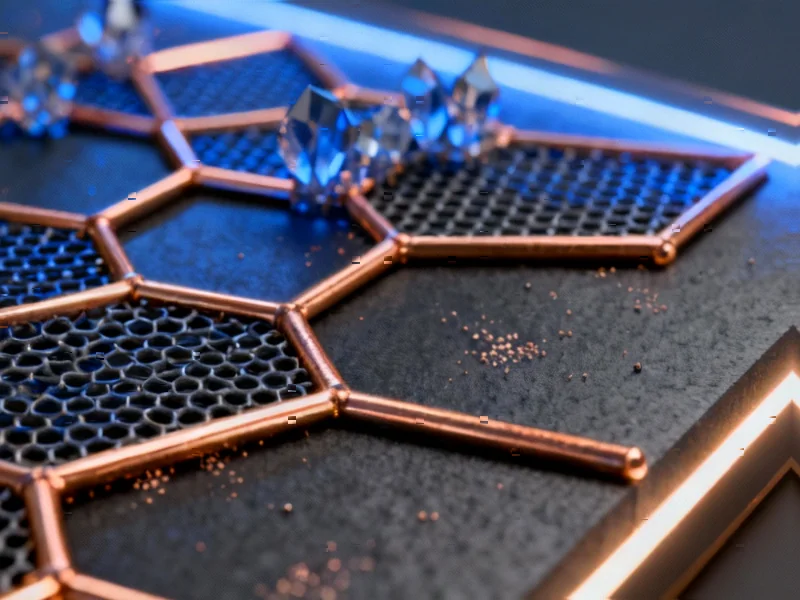Breakthrough in Sustainable Electrochemical Synthesis
Researchers have developed an innovative electrode design that reportedly enables highly efficient electro-organic cross-coupling synthesis of biphenyl derivatives, according to recent findings published in Scientific Reports. The new approach combines copper-based metal-organic frameworks with multi-walled carbon nanotubes in a green deep eutectic solvent system, achieving exceptional yields while reducing environmental impact.
Table of Contents
Novel Electrode Design and Characterization
The research team created a composite electrode material by modifying oxidized multi-walled carbon nanotubes (o-MWCNT) with copper-TCPP metal-organic framework (Cu-TCPP), sources indicate. Comprehensive characterization using multiple analytical techniques confirmed the successful synthesis and unique properties of the o-MWCNT-Cu-TCPP composite.
According to the report, Fourier Transform Infrared spectroscopy revealed distinct chemical fingerprints showing strong interactions between the components, with characteristic peaks shifting and new vibrations appearing. Scanning Electron Microscopy analysis reportedly showed the composite structure features truncated nanosheets on carbon nanotubes, while Energy Dispersive X-ray spectroscopy confirmed the presence and distribution of carbon, oxygen, nitrogen, and copper throughout the material.
Superior Electrochemical Performance
The composite electrode demonstrated exceptional electrochemical properties, analysts suggest. Potentiometric studies revealed that the o-MWCNT-Cu-TCPP electrode exhibited a larger potential window compared to other electrode types tested, including o-MWCNT@Cu, copper foam, and copper rod electrodes. The research team reportedly optimized the reaction current intensity at 10 mA, which produced the maximum potential window for the electrochemical synthesis.
Surface area analysis using the Brunauer-Emmett-Teller method showed the composite material maintains a high surface area of 914 m².g⁻¹ with mesoporous characteristics. Thermal stability studies through thermogravimetric analysis revealed the composite’s decomposition pattern occurs in three distinct steps, providing insights into its structural robustness under operational conditions.
Green Solvent System Breakthrough
A key innovation in this research involves using a Urea/Choline Chloride deep eutectic solvent (DES) as a multifunctional medium serving as solvent, electrolyte, and co-catalyst. The report states that this DES system dramatically improved reaction yields while reducing environmental impacts and production costs.
Optimization studies showed that conventional solvents including water, methanol, isopropanol, acetonitrile, ethanol, and DMSO yielded significantly lower efficiencies ranging from 0% to 58%. However, when researchers switched to the Urea/Chol-Cl DES system, the yield increased remarkably to 95% for synthesizing 4-methyl-1,1′-biphenyl, according to the findings.
Reaction Optimization and Mechanism Insights
The research team conducted extensive optimization of reaction parameters using a model reaction between chlorobenzene and triphenyl bismuth. Their investigation revealed that several factors were crucial for achieving high yields, including the presence of electrolyte, electric current, carbon nanotubes, and the Cu-TCPP framework.
Analysts suggest the high surface area of Cu-TCPP nanosheets increases contact area, thereby enhancing reaction rates. Meanwhile, the DES system reportedly enhances electron transfers due to its high hydrogen bonding capacity and dielectric constant while stabilizing intermediates through its high ionic nature. Time optimization studies showed that reaction times could be reduced to as little as one hour while maintaining 95% yield.
Environmental and Industrial Implications
This electrochemical approach represents a significant advancement in green chemistry methodologies, according to researchers. The combination of MOF-modified electrodes with deep eutectic solvents offers a sustainable alternative to traditional synthetic methods that often require hazardous solvents and generate substantial waste.
The report indicates that the successful demonstration of this technology for synthesizing biphenyl derivatives—important building blocks in pharmaceuticals, agrochemicals, and materials science—could pave the way for broader applications in organic synthesis. The method’s high efficiency, reduced environmental footprint, and operational simplicity suggest potential for scale-up and industrial adoption, though further studies would be needed to confirm commercial viability.
Related Articles You May Find Interesting
- New AI System Promises Breakthrough in Eliminating Lens Flare From Digital Image
- AI Model Uses Texture Analysis to Detect Kidney Damage in Real-Time Imaging
- Oracle Nears Record $38 Billion Debt Financing for AI Data Center Expansion
- Quantum Computing Stocks Surge Amid Potential US Government Investment Strategy
- Solar Telescope Reveals Widespread Twisting Waves in Sun’s Corona
References
- http://en.wikipedia.org/wiki/Mass_fraction_(chemistry)
- http://en.wikipedia.org/wiki/Surface_area
- http://en.wikipedia.org/wiki/Scanning_electron_microscope
- http://en.wikipedia.org/wiki/MOF_F.C.
- http://en.wikipedia.org/wiki/Morphology_(biology)
This article aggregates information from publicly available sources. All trademarks and copyrights belong to their respective owners.
Note: Featured image is for illustrative purposes only and does not represent any specific product, service, or entity mentioned in this article.



